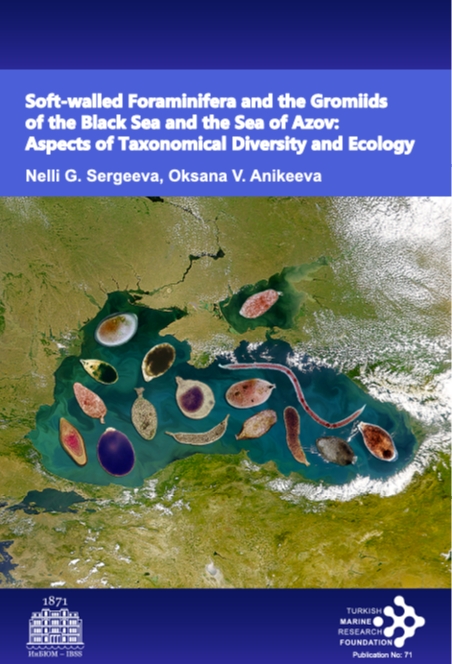Yazarlar: Nelli G. Sergeeva, Oksana V. Anikeeva
Türk Deniz Araştırmaları Vakfı Yayınları
175 Sayfa
ISBN: 978-5-6048081-8-4
2024

Yazarlar: Nelli G. Sergeeva, Oksana V. Anikeeva
Türk Deniz Araştırmaları Vakfı Yayınları
175 Sayfa
ISBN: 978-5-6048081-8-4
2024
SUMMARY
This monograph summaries information on two poorly studied groups of benthic protozoans in the Black Sea and the Sea of Azov – soft-walled foraminifera and gromiids. These protozoans possess delicate proteinaceous tests that are unlikely to fossilize and therefore not of interest to micropalaeontologists and geologists. This limits their utility for studying ancient faunas and their evolution and for addressing important issues in paleogeography. All information about the taxonomy, ecology, and biogeography of these protozoans is based on the study of modern forms. However, benthic protozoans, including soft-walled foraminifera and gromiids, are often not considered by researchers working on benthic communities for various reasons. As our long-term studies of the meiobenthos of the Black Sea and the Sea of Azov have shown, these ptotozoans are very diverse, numerous, with a wide geographical and bathymetric distribution and form an important component of benthic communities under normoxia and hypoxia/anoxia. The main objective of this monographic work is to acquaint the reader with the soft-walled foraminifera and gromiids of the Sea of Azov and Black Sea, to demonstrate their diversity illustrated with images, and to provide brief diagnoses of the valid species as well as those morphotypes that require further study. A summary of information about the taxonomic diversity of soft-walled foraminifers and gromiids is presented, together with a quantitative evaluation of their contribution to meiobenthic communities along a depth gradient across the mixing zone of oxygen and hydrogen sulfide water masses, down to a depth of 300 m, and in closed bays subject to various anthropogenic impacts. We hope this publication will raise awareness of these protozoans among scientists working on benthic ecosystems in the Sea of Azov and Black Sea, as well as elsewhere.
The monograph is intended for a wide range of specialists, including university professors and their students, in the fields of biology, systematics, ecology, environmental protection.
-Introduction 1
Chapter 1: Benthic Monothalamous Foraminifera 5
1.1. The history of study and the current state of the systematics of softwalled foraminifera 6
Chapter 2: Gromiida 12
2.1 The history of study and the current state of the systematics of the gromiids 12
Chapter 3: Material and Methods 15
3.1. Study areas 15
3.2. Sampling and processing methods 17
Chapter 4: The Current State of Study of the Monothalamous Foraminifera and Gromiids in the Black Sea and the Sea of Azov 19
Chapter 5: Taxonomic Review of the Soft-Walled Monothalamous Foraminifera in the Black Sea and the Sea of Azov 24
5.1. General characteristics of morphology of soft-walled foraminifera 24
5.2. Taxonomic composition of soft-walled foraminifera in the Black Sea and the Sea of Azov 25
5.3. Morphological review of the soft-walled foraminifera of the Black Sea and the Sea of Azov 29
Chapter 6: Taxonomic Review of the Gromiids in the Black Sea and the Sea of Azov 98
6.1. General characteristics of the gromiids morphology 98
6.2. Morphological review of gromiids in the Black Sea and the Sea of Azov 99
Chapter 7: Distribution of Soft-Walled Foraminifera and Gromiids in the Black Sea across the Depth Gradient from Normoxia to Constant Hypoxia and Anoxia 107
Chapter 8: Benthic Protozoans as a Component of the Deep-Water Black Sea Meiobenthos 115
8.1. Open sea 115
8.1.1. Istanbul Strait (Bosporus) area of the Black Sea (Turkish shelf) 115
8.1.2. North-western part of the Black Sea (southwestern shelf of Crimea) 119
8.1.3. North-eastern part of the Black Sea (region Caucasus) 122
8.1.4. Shelf zone along the Crimean Peninsula (the Black Sea) 125
8.2. Deep-water methane seepage area (NW of Crimea shelf, Black Sea) 127
8.3. Bays of Sevastopol 131
8.3.1. Kruglaya (Omega) Bay 131
8.3.2. Sevastopol Bay 133
8.3.3. Anthropogenic underground channel in Balaklava Bay 135
8.3.4. Seasonal dynamics of the foraminifera and gromiida density under normoxia/hypoxia conditions in the shallow areas of the Crimea
Chapter 9: Benthic Protozoans as A Component of Bottom Communities at the Sea of Azov 143
Chapter 10: Protozoans in Benthic Food Webs and as Potential Indicators for the Sedimentation of the Azov–Black Sea Basin Bottom Deposits 146
-Conclusion 153
-References 156
Yorumlar
İlk Yorumu Ekle